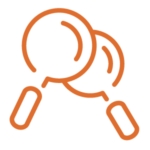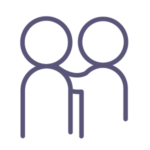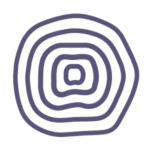In a co-design project, how do you gather a truly insightful understanding of what is happening for communities and individuals? ‘Developing insights with people’ is using design research during the discovery phase. In co-design, it a key part of the discovery process, and is focused on understanding the perspective of people you are working with and what is meaningful to them. This capability involves listening and understanding what is, what could be, and what might be from the perspective of the people you are developing insights with. It is about meeting people where they are and suspending judgement and interpretation of information. It is about treating people with lived experience of a situation as experts in their situation. ‘Developing insights with people’ through design research is external facing, finding out what is going on with people, as opposed to other forms of research that may also be needed.
The ideas and stories captured here were shared by members of the Regional Innovator’s Network (RIN) during a peer learning session on 18 September 2018.
Quick Summary
What does it mean
- Why do we want to develop insights with people?
- A key component of discovery
- Design research – for our creativity
- Methods to use for design research
- Getting ready
- Planning the high-level schedule
- Designing your research
- Ethics considerations
- Prepare your detailed conversation guide
What helps
- Co-design lens: ‘do with not for’
- Create a relaxed environment
- Engaging people to develop their own ideas
- Interview in pairs
What hinders
- Recruitment can take longer than you think
- Gritty feedback
What does it mean?
Why do we want to develop insights with people?
The goal of developing insights with people through design research methods is to go beyond traditional interviews – because when we understand more deeply, or when we see things differently, it helps us develop different ideas – it helps us be innovative. It also helps us design for what people value, versus what they say they want or what they want today – because people find it very different to anticipate what they will value in the future
Reason for taking a design research approach
– Learning from people is how we gain depth of insight into a situation
– It often gets left out
– It helps us get on the right track at the beginning of a project – so that our ideas address the real issues or link to promising opportunities
– It helps us get clarity when it’s not clear what’s going on
– It helps when consultation doesn’t work
Developing insights with people is not straightforward – what people say or describe (and how we interpret that) is not always what is happening. We have to develop keen skills for listening, asking questions and interpreting what people offer.
Want to know more? See a more detailed explanation about the mindset and philosophy of this research approach in the context of co-design in the following video.
A key component of discovery
Discovery is a process of understanding what is (knowns, unknowns and assumptions) and what could be (hopes, dreams, goals) in order to find what might be (new possibilities). In the discovery phase, design research focuses on spending time with people to hear, observe and seek to understand their lived experience; it is about finding out what’s going on with people, through their words and actions and ways of seeing.
The information we learn from design research can be enriched with other research methods such as desktop research, literature reviews, data analysis, exploring analogous contexts and systems mapping, etc. Developing insights with people is an inherently qualitative approach and, especially when combined with other forms of research (including quantitative approaches), it can yield powerful data that is conveyed through insights and stories – in the voice of people.
Design research – for our creativity
This is a bit technical…but bear with us! Design research originated within the field of design, particularly product design and human-computer interaction design. For a potted history, check out the Wikipedia article: https://en.wikipedia.org/wiki/Design_research. In social innovation, design research approaches have been blended with approaches from ethnography, action-research, participatory design and other disciplines. All of these approaches have been necessary to forge a social innovation practice that truly sees people as experts in their own experiences and enables them actively contribute to the design process as co-designers.
Despite this knitting of many practices, we still refer to the approaches we use as ‘design research’ because the unique fingerprints of design can be found in the creative and generative qualities of our approaches. Tapping into people’s creativity and imagination so that we can understand and see in different ways is core to the purpose of design and research techniques specific to design. Design acknowledges that there are many forms of wisdom and believes in the power of creativity – especially when we are looking to make new futures. Design, and design research, is inherently generative: it is about bringing (new) ideas to life. And so, when we conduct design research we do not just seek to understand, but to create new possibilities as well.
Methods to use for design research
Particular design research methods are used in discovery to gather insight with people and communities. Here are a handful of some of our most commonly used design research methods:
– Rapid ethnography: Also known as ‘rigorous hanging out’, rapid ethnography is a deep dive into a person’s life that can last a few hours, a day or – with more intensive research – for weeks. It means that you will spend time in context with whoever you’re studying, doing what they do, capturing what they say and observing their life. This process may show that what a person says in an interview situation is not the same as what they actually do and may uncover latent needs and motivations.
– Semi-structured interviews: Different from scripted interviews that are rigorously structured (commonly seen in surveys, market research and traditional academia), the semi-structured interview is formed around themes that let the conversation flow through relevant topics related to the research. Instead of developing a script, key research questions and an interview guide are developed. Typically, an interview will last from half an hour to three hours. It works well with generative activities to engage interviewees in creative ways.
– Card sorting: In a card sorting activity, participants are offered a deck of cards that may consist of images, words and phrases, and/or symbols, etc. – whatever the design researchers feel will tap into the emotive and creative parts of our brain and stimulate thinking. Card sorting is a flexible method that can be used for focussing a conversation and getting insights quickly. Card sorting is often used as part of semi-structured interviews to engage participants in a tactile and visual way and learn what they intuitively respond to. It can also be helpful in breaking the ice, getting people’s minds working on a topic, stimulating memories and details, as well as eliciting and unpacking difficult stories.
– Participant diaries: Participant diaries are a great way to get insight into a context and habits when you can’t be there to observe in person. Get your participants to document the journey you are interested in, be it a service experience, their home, what they eat, or their morning commute, etc. It is possible to use this method alongside a semi-structured interview to compare what people say and what they do. Diaries can be done with a journal, booklets with structured questions, photos, videos, etc.
“I found with the card sorting exercise it’s a bit of a Pandora’s Box: sometimes you can get a lot more information than you first anticipate.” – Lana Masterson, Down the Track Project Coordinator
“The diving deep naturally happened. It’s the curiosity and the willingness to sit with it. Like the swiss cheese with holes” – Shane Phillips, Lake Cargelligo Community Connector
Getting ready
- Planning the high-level schedule
Good planning is the ultimate backbone to any project. Use a visual method such as a spreadsheet or a piece of paper on the wall. Build a timeline with enough time for pre-planning, recruitment of people you need to speak to, interviews and other activities (like workshops), bringing it all together (synthesis), and presenting the information back. Understand how the discovery timing will fit with the other phases of the work.
“One of the things I really liked about this was doing it with the usual post-it notes and it gave us the flexibility to do the timing. So, where it didn’t work out for me or the team I’d just move that task. That was really helpful in taking the pressure off feeling I had to meet these criteria or these dates, to make things fit. I’m working with a school so there’s already limitations to what I can and can’t do and what’s available so having the flexibility in the discovery planning I found really helpful. And I just had it on my wall. Big butchers paper…all these post-it notes…allowed me to shift lots of that”. – Shane Phillips, Lake Cargelligo Community Connector
- Designing your research
Plan out your approach using the following guide:
- Gather existing information – do some desktop research and find out if anyone has done something similar before, or has any information that might help you. Especially find out if a project like yours has been done recently with the same cohort of people – and particularly in the same area in order to avoid duplication and over-researching a group of people. If work has already been done, try to integrate some of these findings into your project. Use all the existing research to guide where you may need to focus, and what you want to learn.
- Lines of enquiry – outline the key research questions and create themes, or lines of enquiry, in order to guide you when you go into interviews and workshops with people. You may not remember or ask the specific questions you have written (in the way you have written them), but the lines of enquiry will keep you on track to learn what you need to know.
- Define tools/methods to explore questions – Spend some time getting creative about the different research methods you can use and activities you can do with people in order to elicit the responses you’re seeking
- Identify who you want to talk to and scheduling time to meet with them; name different cohorts if that is relevant
- Ethics framework – Identify any ethics concerns and set out how you will manage these ethics. Include consent to participate and use people’s information. See below, ‘ethics considerations’.
- Vouchers / thank yous – Establish how you will remunerate people for their time. In co-design, the people we seek to learn from are doing as much work as we are. We respect their experience, the work they are doing with us and the time that they have dedicated – without their participation the research would not be possible. For these reasons, we try to provide vouchers and thank yous whenever possible. We try to budget an amount for vouchers that would be equivalent to a minimum wage reimbursement for their time.
The following two videos expand on the above and give very detailed information about how to go about designing a robust research approach.
“The information we got off the tools was so rich.” – Sharon
- Ethics considerations
Referencing ethics guidelines can be useful for any research, but they are a must when working with young or vulnerable cohorts. Core to an ethics process is ensuring that participants consent to be part of the research and know what will be done with their data. Consulting with an ethics guide will help the researcher craft appropriate questions, steer generative sessions, adhere to appropriate behaviours and protocols, and set out communications and consent forms.
Consent forms are provided at the start of a session, or in an initial conversation. Participants are guided through an explanation of the project and the consent form and asked to sign the form to acknowledge their consent and to indicate whether pictures (e.g. identifiable, non-identifiable or none) and recordings are allowed. The researcher is asked to stress the opportunity for the participant to opt out at any time. It may feel awkward going through the consent form, but keep in mind – and even say to participants – that the purpose is to empower them, to ensure they know that the information they share belongs to them and that they can determine what they do and don’t answer, and the extent to which they participate.
- Prepare your detailed conversation guide
A detailed conversation guide helps interviewers direct a conversation based on the key research questions that have been identified. It is not an interview script, but more a set of topics to cover, questions for which answers are needed and data that you seek to gather. A guide includes the introduction and framing to the project to help you get started with an interview and provide consistent information. An example structure for a conversation guide is:
– Begin with introductions and consent
– Set out an overview of the project, the process and the key parties involved
– Getting to know each other – initial questions that allow the participant to relax into the session
– Understanding the past and/or present: questions to explore the past or current lived experiences
– Generative ideas: explore ideal future scenarios and/or new ideas. This exercise is conducted at the end of the conversation, when people’s minds are more prepared but without pre-determining anything they might say in the earlier questions
– Thank you to participants (provide the voucher), next steps, timing and whether to expect further contact and communication
What helps?
Co-design lens: do with not for
‘Doing with not for’ is the mindset of learning from people and their perspective on their own lives. It means meeting people where they are at and looking for ways to eliminate our own bias in order to understand how they see their experiences. For this reason, direct quotes are often used in presenting what was learned. The mindset of ‘doing with not for’ also acknowledges that, when engaged appropriately, people can develop their own ideas, and that these ideas are often more relevant to them and tailored to their situation.
Creating a relaxed environment
New ideas surface when the participant is at ease and able to connect ideas for themselves and with you. Be sure to spend some time getting to know them – and for them to get to know you. Find ways to create a sense of friendliness, ease, good humour and human warmth – which usually comes from you being you. When you are authentic, it creates a space where others have permission to be authentic too. It may be important to create cultural safety for some participants to be important, find more information in the module on ‘Cultural Awareness’.
Engaging people to develop their own ideas
The methods in this phase can be used with generative tools to start engaging people in creating and building on their own ideas. Combining semi-structured interviews with card sorting or activities that let the interviewees draw, see, or add to the process is one way to quickly get them engaged in creating their own ideas. Participants often have a whole new level of energy and buy-in when they see their own ideas respected, developing and growing.
Interview in pairs
Try not to interview alone! Having two people doing an interview distributes the responsibilities and allows for more information, richer information to be gathered. Typically, one person will take the lead interviewer role asking the key questions and running any activities. The other person will be the note taker and critical listener: taking notes, observing any behaviours, prompting questions and probing further.
What hinders
Recruitment can take longer than you think
Recruitment can take a while depending on the cohorts you are trying to reach and your connection to them. Finding people that are willing to talk to you from disengaged and/or vulnerable cohorts can be especially time consuming, so it’s best to allow extra time for this in your planning. It may take time to make contact with the people you wish to reach and you may need to spend time building relationships before an interview or any other form of participation is possible.
Gritty feedback
Gritty and negative feedback comes with the territory but it doesn’t have to define the project or an interview. If you have received negative feedback about something and it’s important to share it back honestly with appropriate stakeholders, take a bit of time to frame the feedback and consider how you will share it. Feedback can come through as judgement, criticism and even condemnation, and that may trigger a negative and closed reaction. If your goal is to create a different way forward, you’ll need to frame the feedback in a way that doesn’t overplay the negative, misconstrue the meaning, or hide the grittiness. You’ll also need to frame the feedback in a way that sets people up to see opportunities and a way forward.
“The more honest [the information] is the more gritty it is. It can be difficult if you have a relationship with the person or people that you’re feeding back to because nobody really likes to hear the negative stuff but I think that needs to come out to develop insights. It just means being able to really sit with people in the feedback process while they listen and understand.”. – Sharon Tomas, Dubbo Community Connector and CAPP Coordinator
Related Capabilities:
- Making it happen https://regionalinnovation.com.au/network/capabilities/mindsets/making-it-happen: Useful skills to compliment the discovery phase. What do you need to plan, who do you need to contact to make it happen?
- Facilitating meaningful and productive conversations https://regionalinnovation.com.au/network/capabilities/skill-sets/meaningful-conversations: Working with some groups can be tricky to manage. Having facilitation skills to keep the conversation going, or introducing tools to enable discussion are handy to these situations.
- Bringing others along on the journey https://regionalinnovation.com.au/network/capabilities/skill-sets/bringing-others-along: This is important to remember as this skill set reminds you to feed back your learnings and insights to the people that helped create them
- Thinking and acting strategically towards your broader goal https://regionalinnovation.com.au/network/capabilities/skill-sets/thinking-strategically: It’s useful to keep in mind the broader purpose of the research you’re conducting as it’s easy to get lost in people’s stories. Acting strategically means being aware of how the insights will feed into the larger project and designing the research accordingly.
Resources
- Consent form
- Conversation guide
Frameworks and Resources:
- Overview of our approach to Discovery and Design Research (presentation)
- Discovery handbook and guide [NEW!]
- Interviewing fundamentals (presentation) [NEW!]
- Example: Discovery planning timeline
- Example: Discovery planning tasks
- Example: Discovery conversation guide
- Example: Researcher notebook [NEW!]



